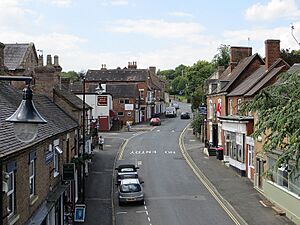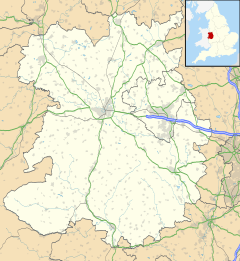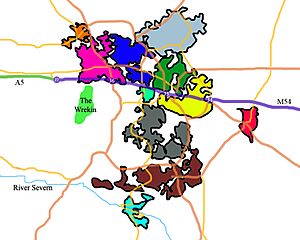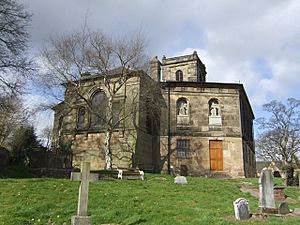Madeley, Shropshire facts for kids
Quick facts for kids Madeley |
|
|---|---|
| Town and civil parish | |
 High Street, Madeley |
|
| Population | 18,774 (2021 Census) |
| OS grid reference | SJ697044 |
| Civil parish |
|
| Unitary authority | |
| Ceremonial county | |
| Region | |
| Country | England |
| Sovereign state | United Kingdom |
| Post town | TELFORD |
| Postcode district | TF7 |
| Dialling code | 01952 |
| Police | West Mercia |
| Fire | Shropshire |
| Ambulance | West Midlands |
| EU Parliament | West Midlands |
| UK Parliament |
|
Madeley is a historic town in Shropshire, England. It's part of the wider area called Telford and Wrekin. In 2021, about 18,774 people lived here.
This town is very old, even mentioned in the Domesday Book. Madeley started before the 700s. For a long time, people in Madeley worked in mining. Later, many jobs were in making things (manufacturing). Today, manufacturing and service jobs are still important. Part of Madeley is even a UNESCO World Heritage Site. This special area is called the Ironbridge Gorge, famous for The Iron Bridge. It was a very important place during the start of the Industrial Revolution.
Contents
History of Madeley
Madeley is a really old settlement. It was mentioned in the Domesday Book, which was a big survey done in 1086. The town actually started before the 700s. By the 1200s, Madeley became a busy market town.
A local leader named Sigward owned land in Madeley around the 700s. He sold his land to Mildburh. She was the daughter of a local sub-king. Mildburh founded a monastery nearby. Madeley belonged to this church for hundreds of years. This was until the monasteries were closed down in the 1500s. Then, the land was sold to Robert Broke, a famous lawyer.
People started digging for coal in Madeley before 1322. By 1540, they were also digging for ironstone.
During the English Civil War in 1645, soldiers loyal to the King stayed in Madeley. But they left when Shrewsbury fell. Later, Parliament's soldiers took over the local church. After a big battle in 1651, King Charles II hid in a barn in Madeley.
In the 1600s, Madeley was a small market town. Local workers started to focus on river trade and mining. In the 1700s, The Iron Bridge was built nearby. A new settlement called Ironbridge grew up around it. This new place took some business away from old Madeley.
Still, Madeley was a key part of the Coalbrookdale Coalfield. There were almost 100 known coal mines in the area. Coal mining continued until the early 1900s. In 1864, a sad accident happened at the Brick Kiln Leasow mine. Nine miners died while digging for ironstone. They are remembered as the Nine Men of Madeley.
In the 1970s, many new homes and parks were built in Madeley. This was part of creating the new town of Telford.
You can visit several historic places in Madeley. They are part of the South Telford Heritage Trail. These include Madeley Court, Madeley High Street, and St Michael's Church. The gatehouse of Madeley Court is a very important old building.
How Madeley is Governed
Madeley is a civil parish and also a ward. A ward is an area that elects local representatives. Madeley is part of the Telford area. This area elects a Member of Parliament (MP) to the UK Parliament.
Madeley has its own local council called the Madeley Town Council. This council looks after Madeley and nearby areas like Sutton Hill. It also covers industrial areas. The Town Council has different parts called electoral wards. These wards elect councillors to represent them. Most of the councillors in Madeley are from the Labour party.
The town is also managed by Telford and Wrekin. This is a bigger local government body. It helps run services for the whole area. Madeley used to include Ironbridge. But Ironbridge is now its own separate parish.
Geography of Madeley
Madeley is in the southern part of the new town of Telford. It is north of Ironbridge and the River Severn. Coalport is a part of Madeley parish, located to the west. The main Telford town centre is north of Madeley. The area around Madeley has lots of coal and ironstone.
A part of the famous UNESCO World Heritage Site is in Madeley. This site is the Ironbridge Gorge. Most of the Gorge area is in a different parish. But Madeley is still an important part of this historic landscape.
Economy of Madeley
In the past, Madeley was mainly a mining town. It had mines like Kemberton Colliery. The Madeley Wood Company was also important.
By 2001, making things (manufacturing) was still a big employer. About 33% of people worked in manufacturing. Many others worked in shops, hotels, and business services.
Transport in Madeley
The B4373 road goes through Madeley. The A4169 road runs along its northern edge. The closest big motorway is the M54. This road connects Telford to other big cities. Most local bus services are run by Arriva Midlands. There is also a community bus service.
Near Madeley is Madeley Junction. This is a place where railway lines meet. It used to carry coal to Ironbridge Power Station. The closest main train station is Telford Central. Madeley also had its own train station from 1860 to 1952. The old railway path is now part of a walking trail called the Silkin Way.
Education in Madeley
Madeley has several nurseries and primary schools. There are also two secondary schools. These are Haberdashers' Abraham Darby and Madeley Academy. Haughton School is also in Madeley. It is a special school for younger students.
Religious Sites in Madeley
There are three churches in the centre of Madeley. St Michael's is a Church of England church. It was designed by a famous engineer, Thomas Telford. There is also Madeley Baptist Church. The Roman Catholic St Mary's Church is also in town. The Fletcher Methodist Centre is another religious building. The Springfield Christian Fellowship is on the Tweedale Industrial Estate.
Notable People from Madeley
Many interesting people have lived in Madeley.
Sir Basil Brooke was born in Madeley in 1576. He was very important in the Industrial Revolution. His grandfather was a former Speaker of the House of Commons.
Mary Bosanquet Fletcher was one of the first female Methodist preachers. Her husband, John William Fletcher, was the Vicar of Madeley. They worked together in the church in the 1700s. John's special iron tombstone is in the churchyard.
Major Charles Allix Lavington Yate lived in Madeley. He won the Victoria Cross for bravery in the First World War.
Other Notable People
- Abraham Darby I (1677–1717): A pioneer in making iron. He lived and died at Madeley Court.
- Richard Reynolds (1735–1816): Another important iron master. He owned Madeley Court.
- Abraham Darby III (1750–1789): Also an iron master and Abraham Darby I's grandson.
- Joseph Anstice (1808–1836): A scholar and writer of hymns. He was born in Madeley Wood Hall.
- Sir Wyke Bayliss (1835–1906): A British painter, author, and poet. He was born here.
- John Fletcher Moulton, Baron Moulton (1844–1921): A judge and politician. He was born in Madeley.
- Edith Mary Pargeter (1913–1995): A famous English author. She lived in Madeley for many years.
Sports Stars
- Matthew Webb (1848–1883): The first person to swim across the English Channel. He lived in Madeley as a child.
- William Dyas (1872–1940): A first-class cricketer and local politician. He was born and died in Madeley.
- Richard Guy (1877–1938): A professional footballer for Manchester City.
- Billy Wright (1924–1994): A famous football player. He was captain of Wolves and the England team. He went to school in Madeley.
- Richie Woodhall (born 1968): A former boxer. He won a bronze medal at the Olympics and was a world champion. He also went to school in Madeley.
- Rob Edwards (born 1982): A former professional footballer for Wolves and Wales. He was born in Madeley.





